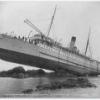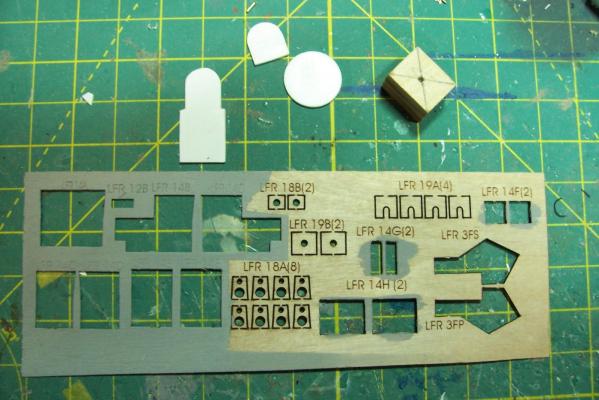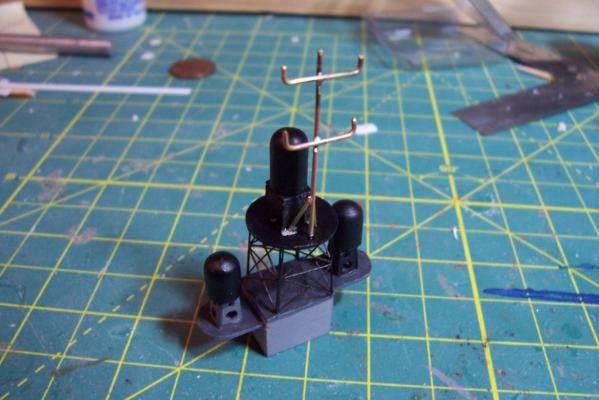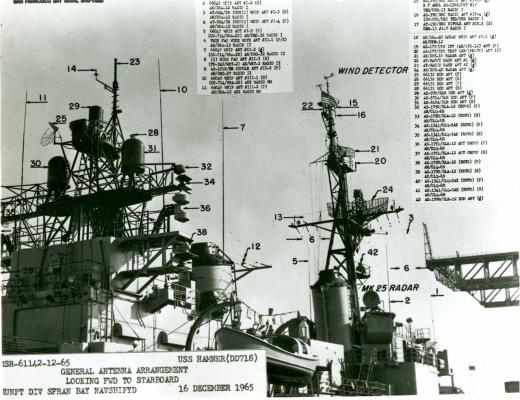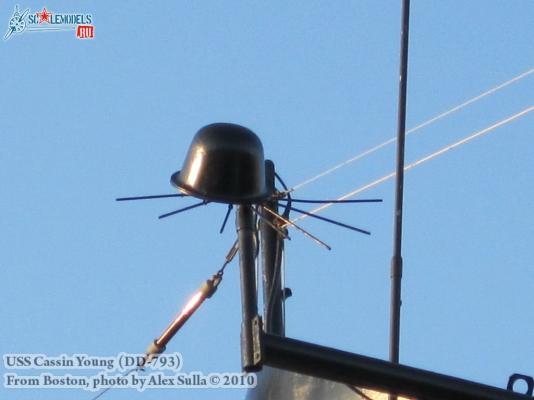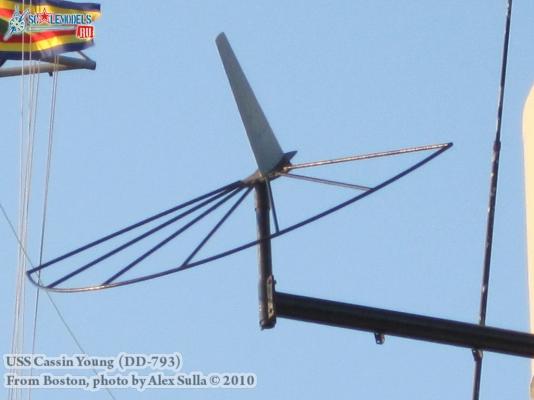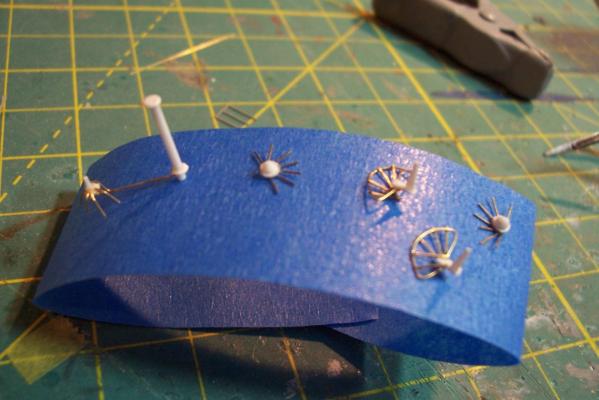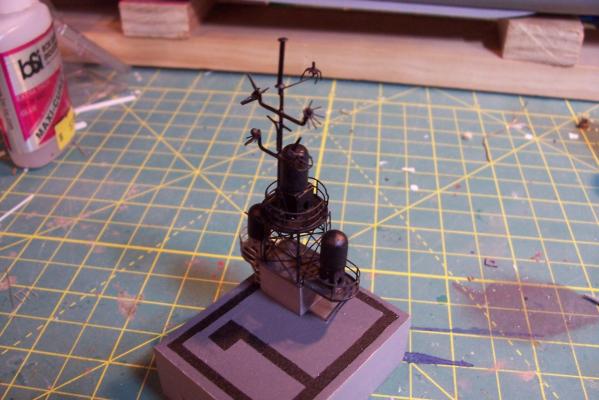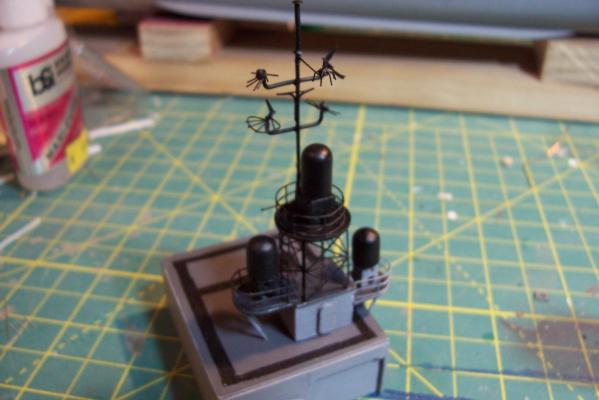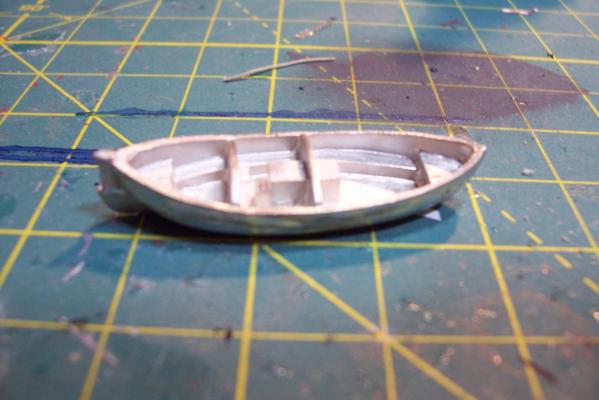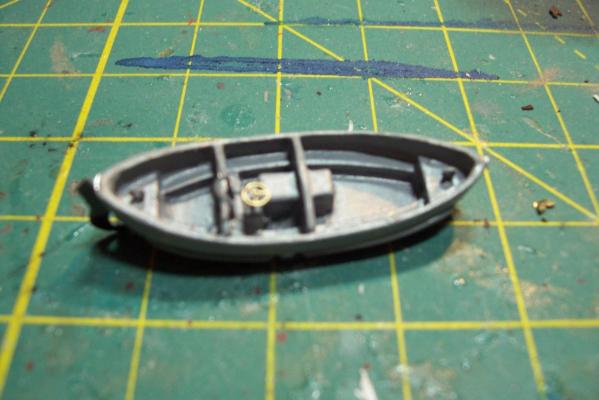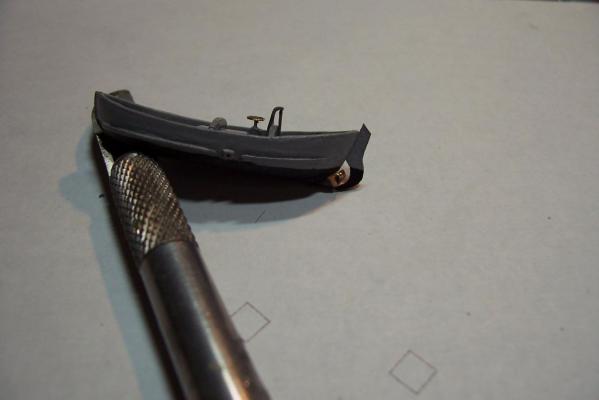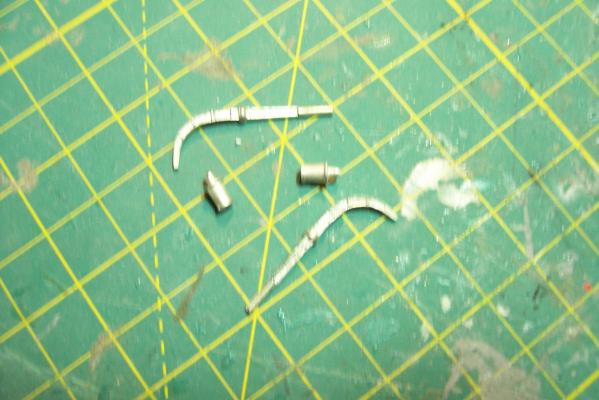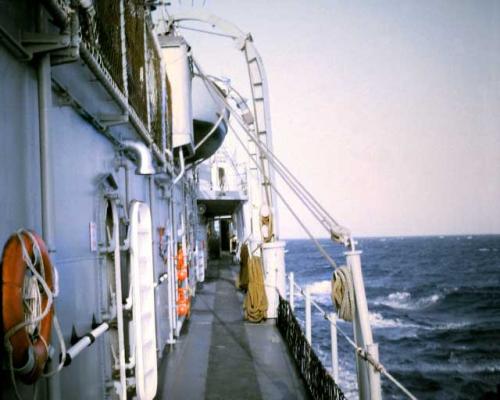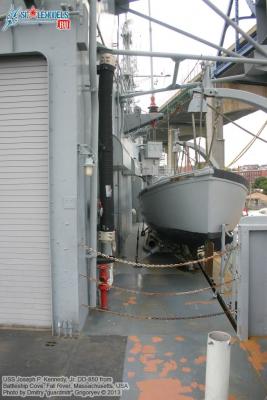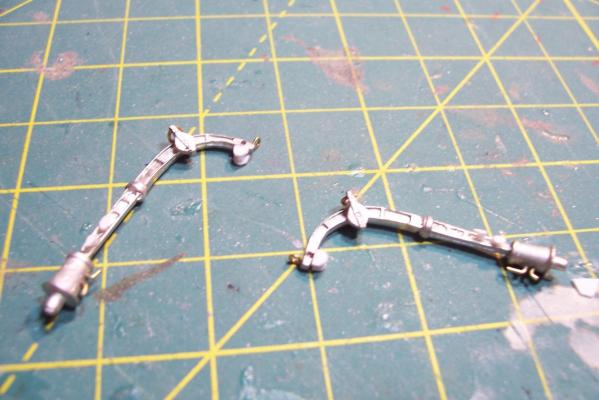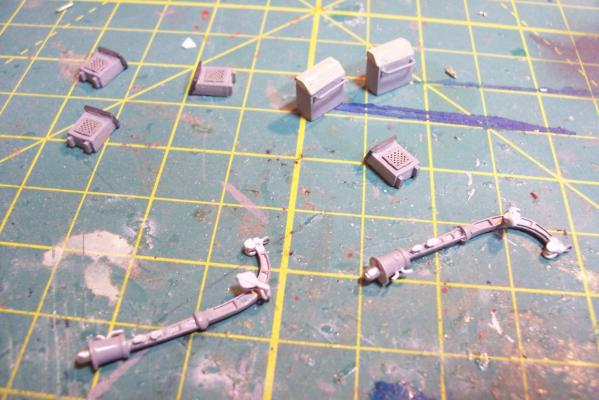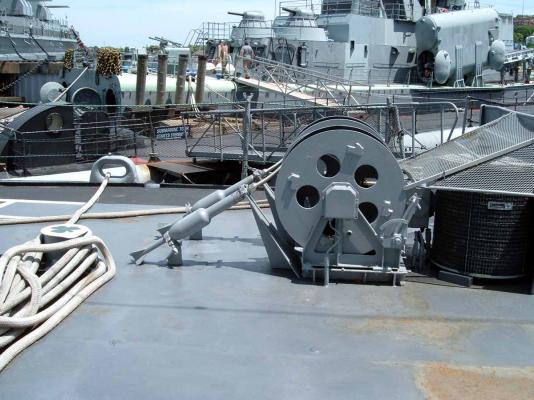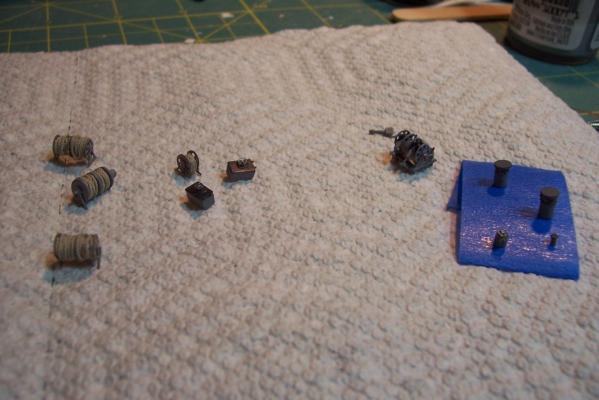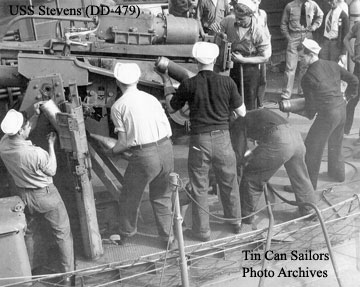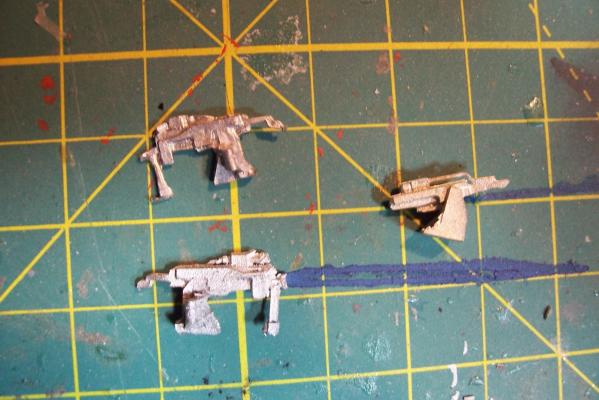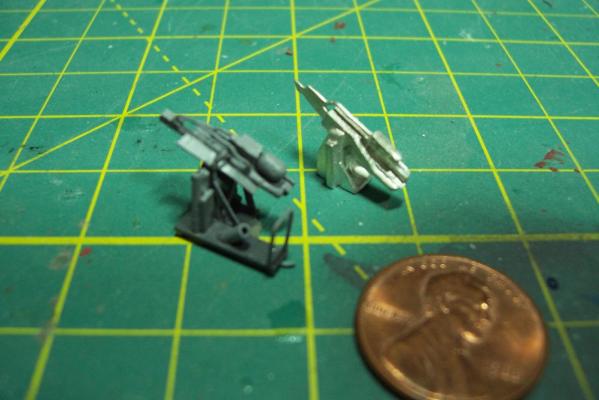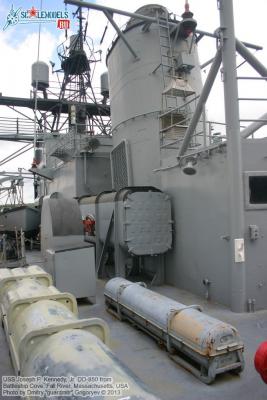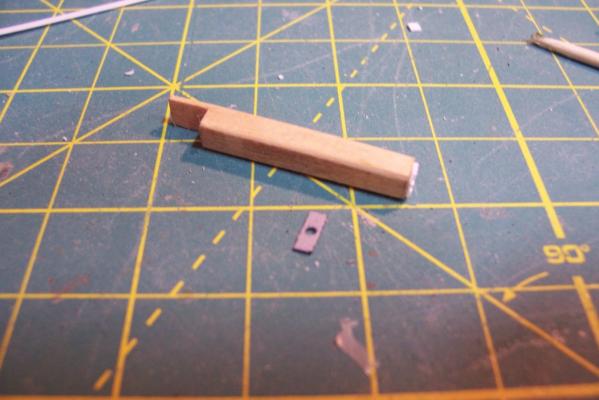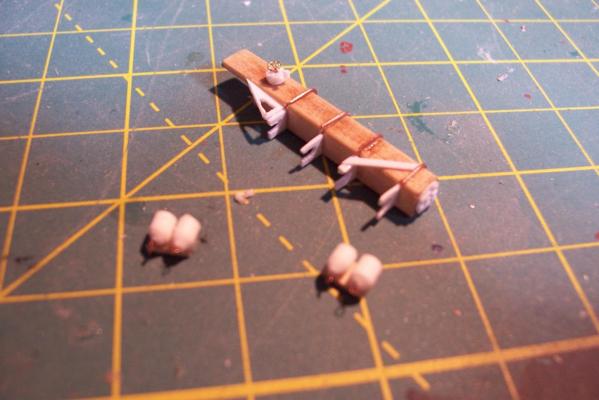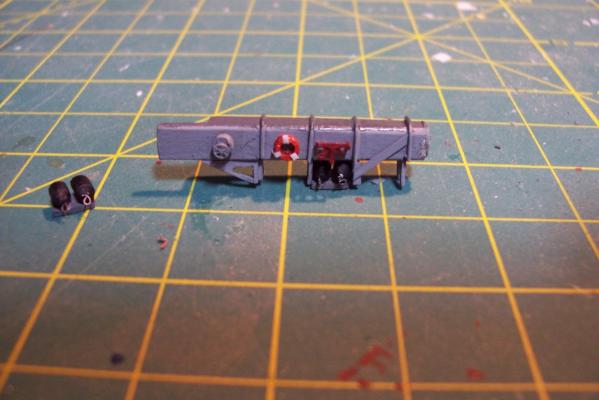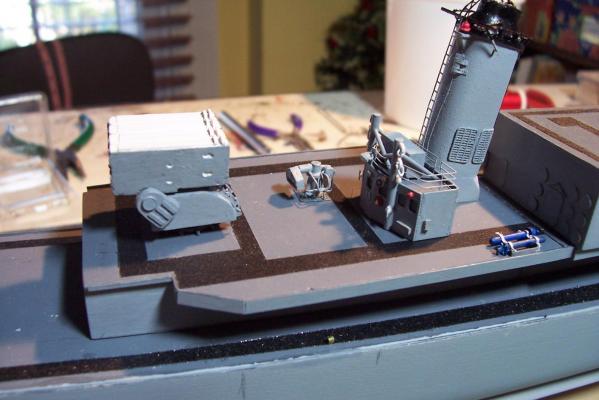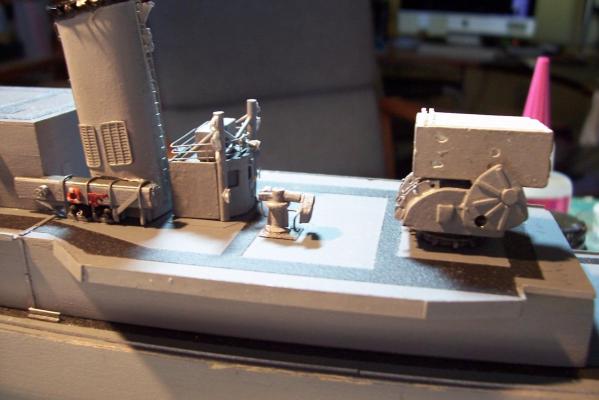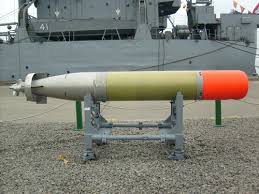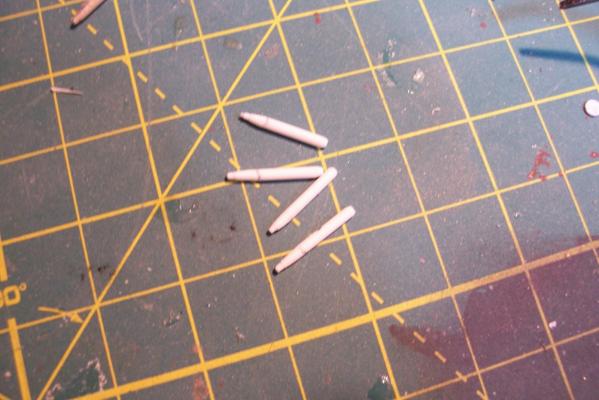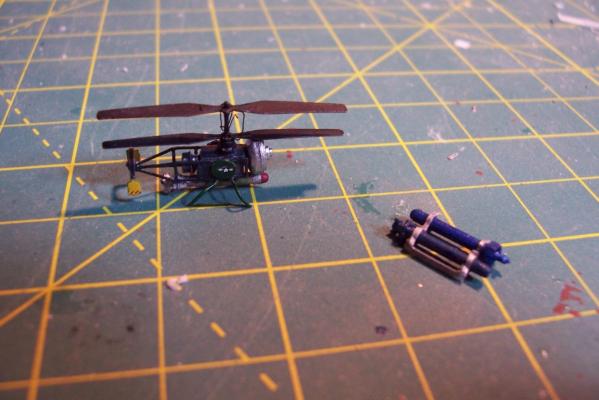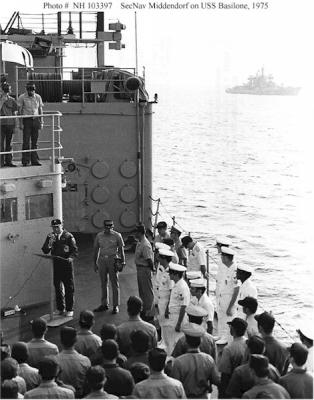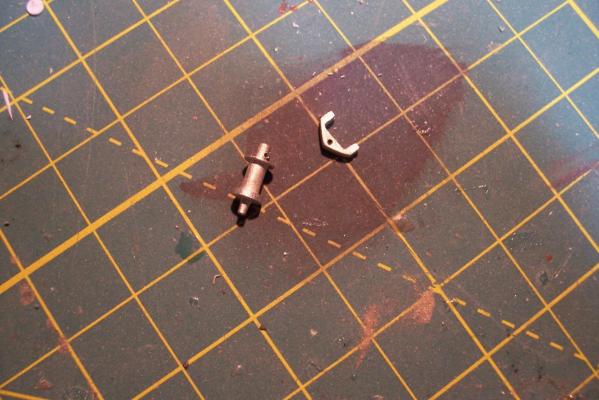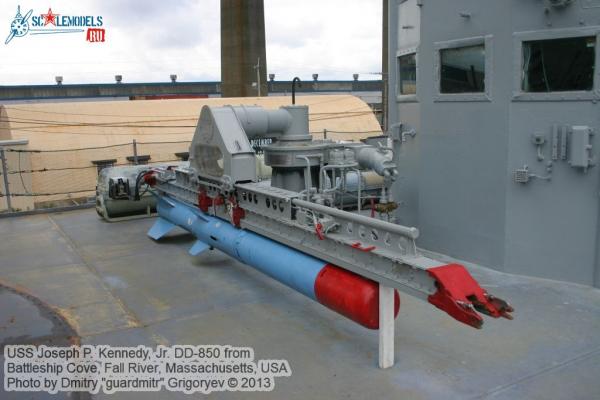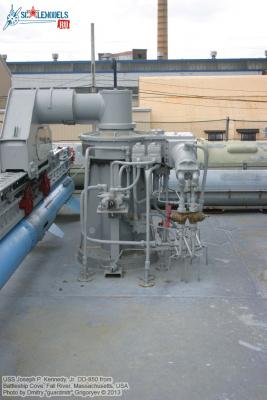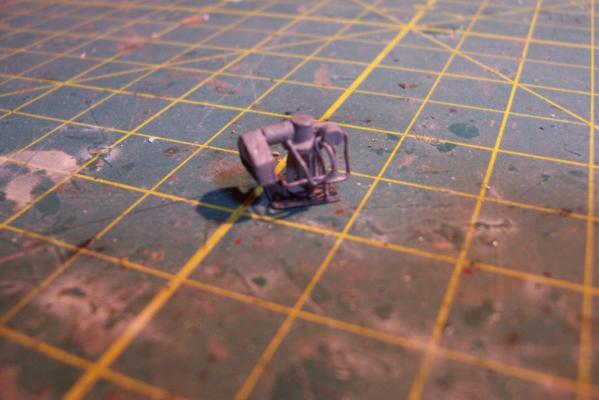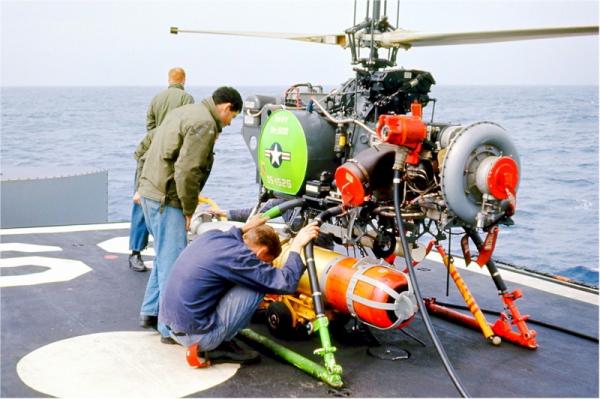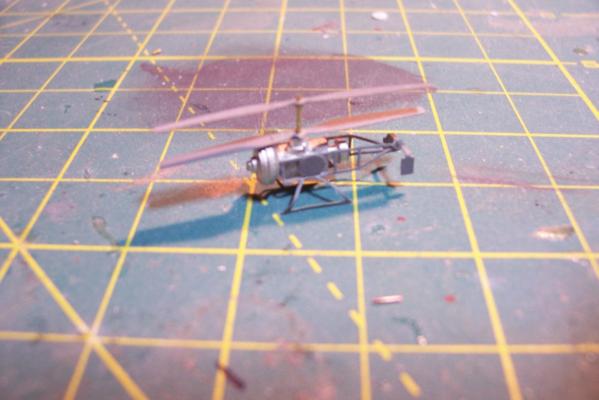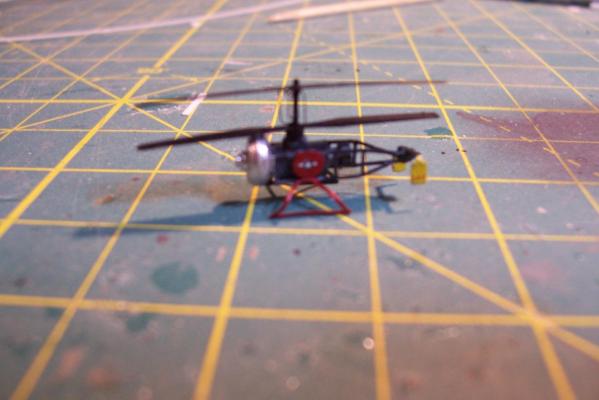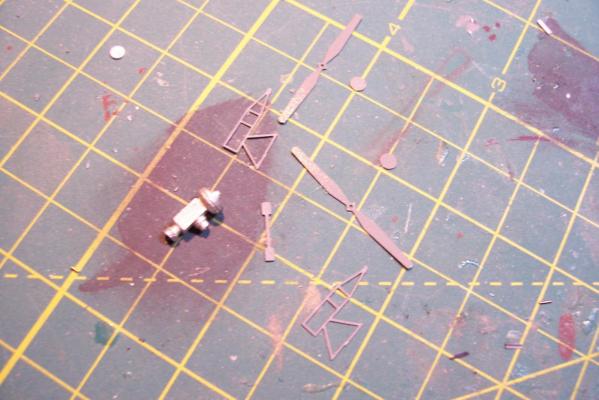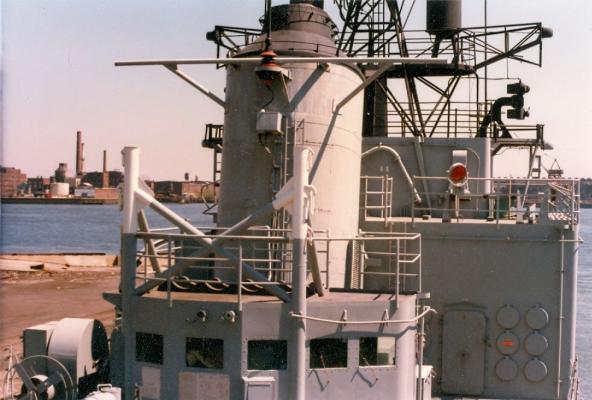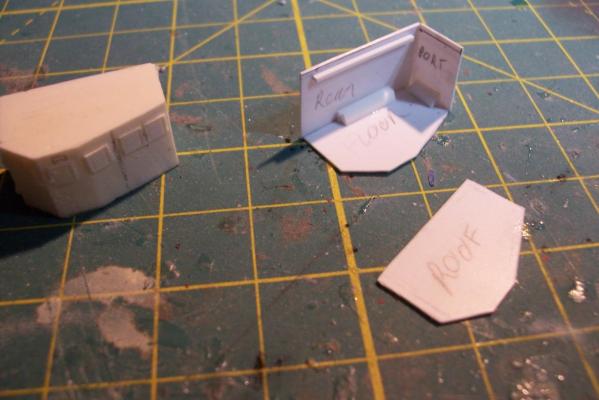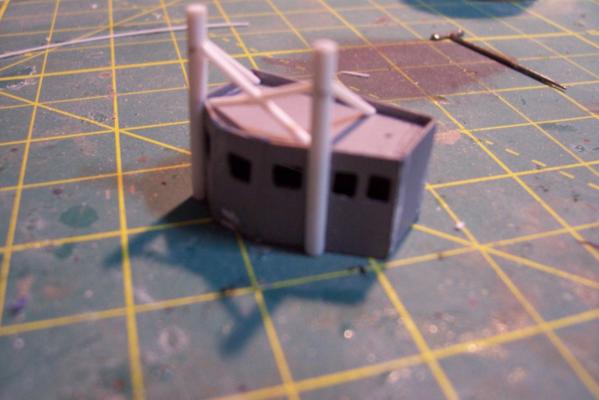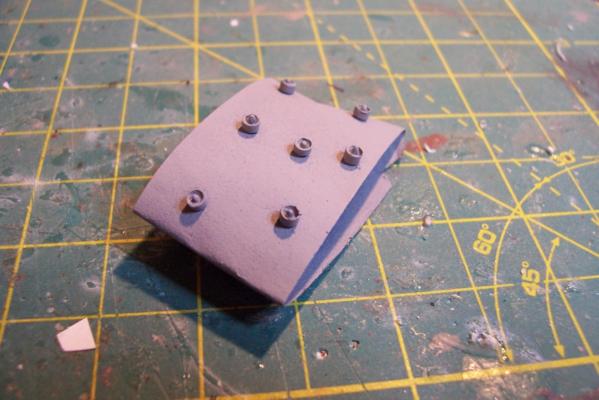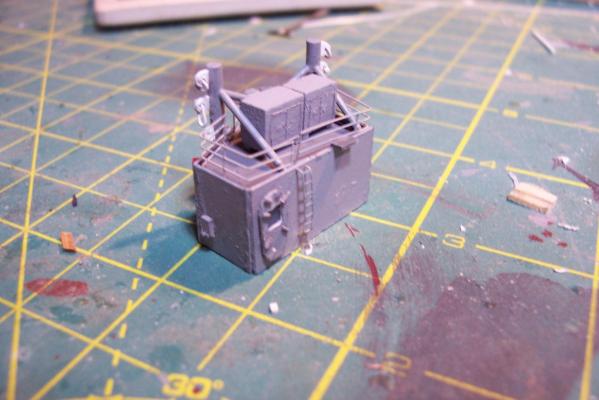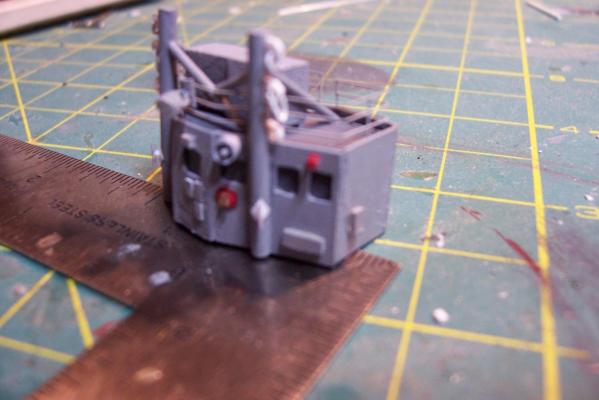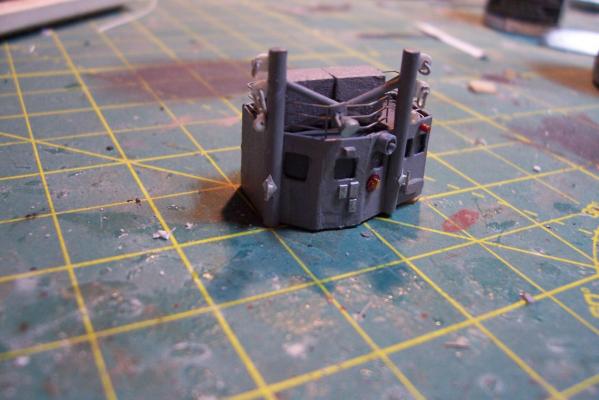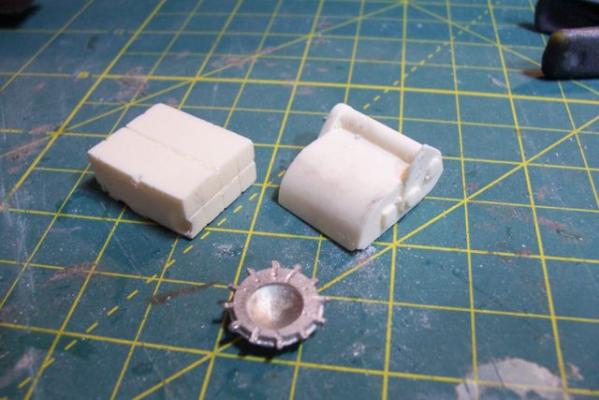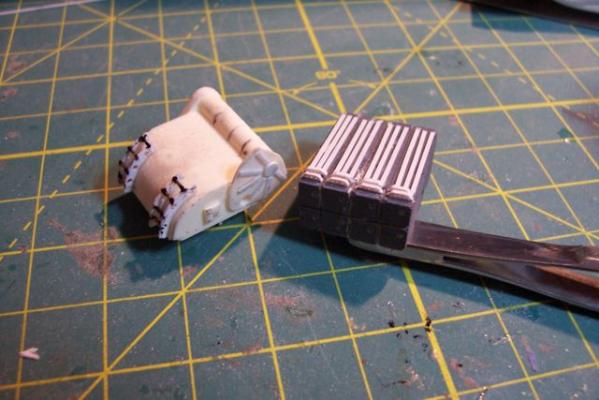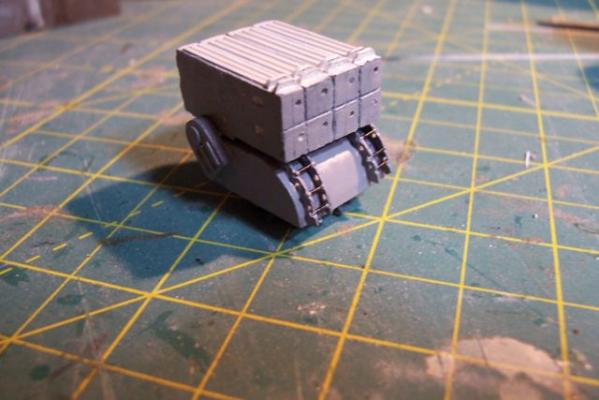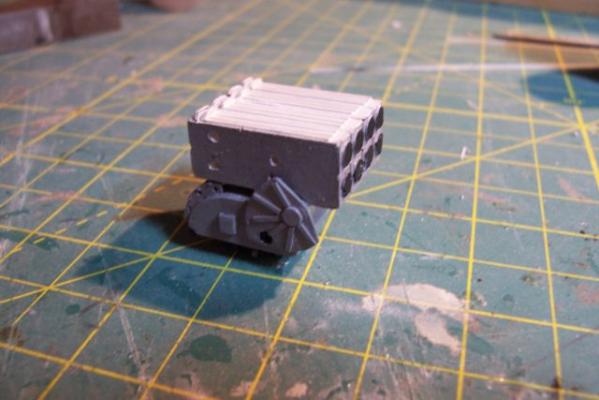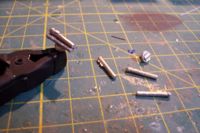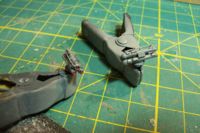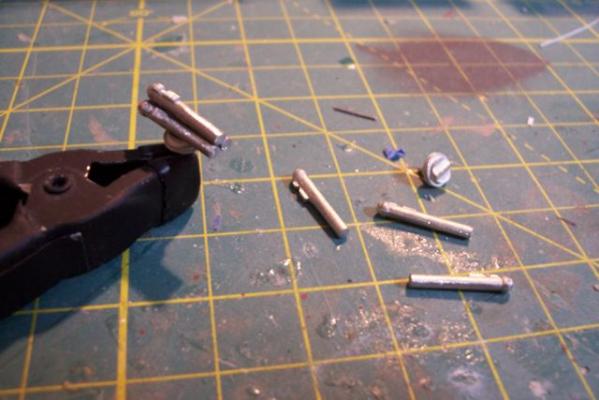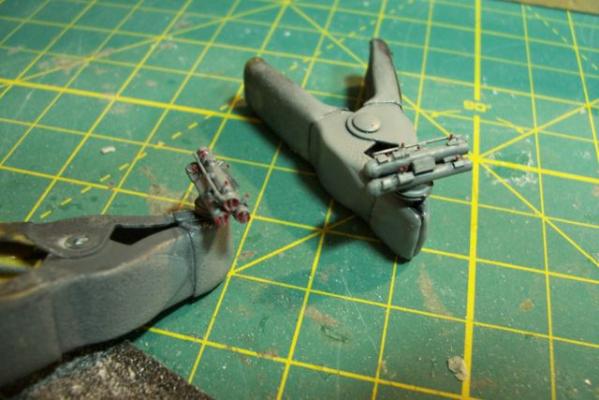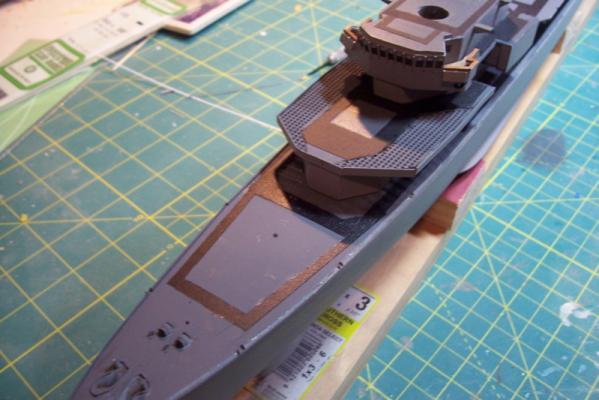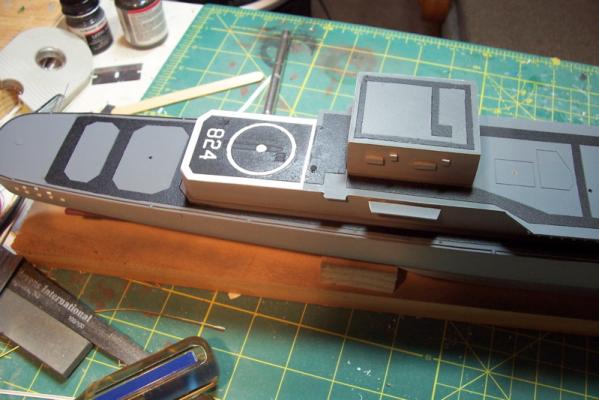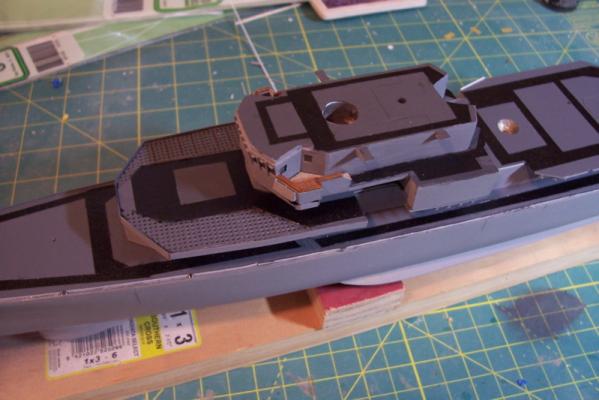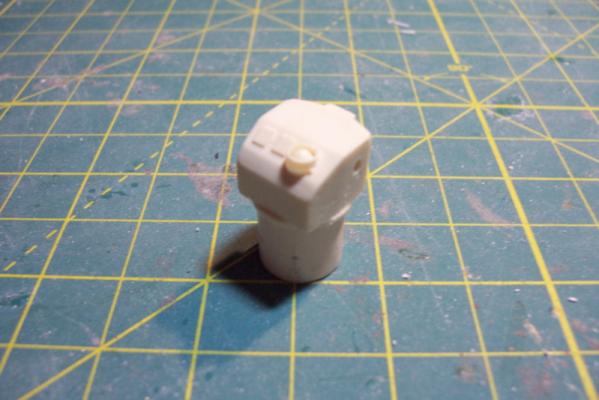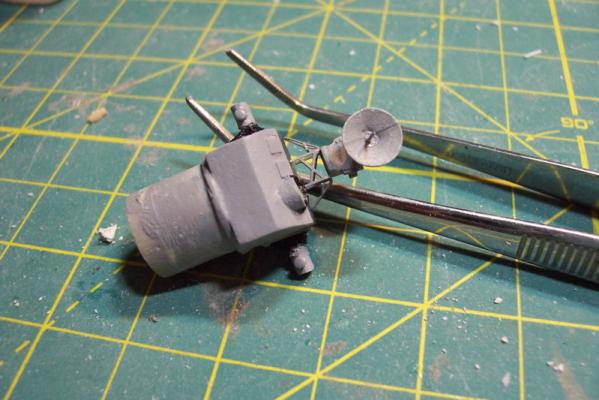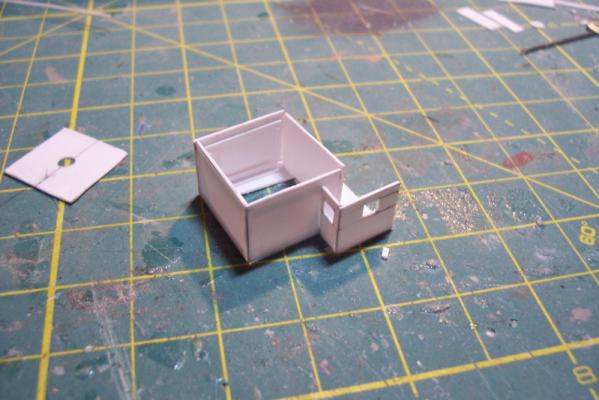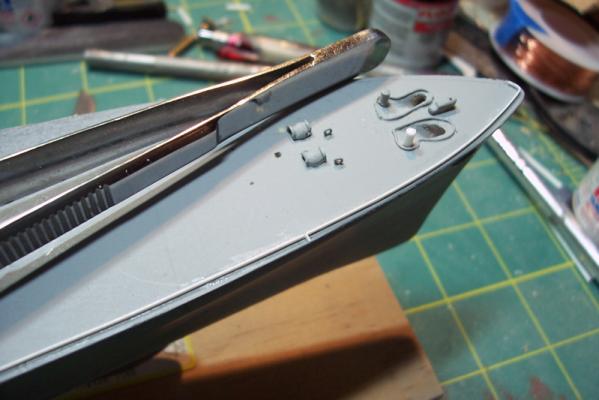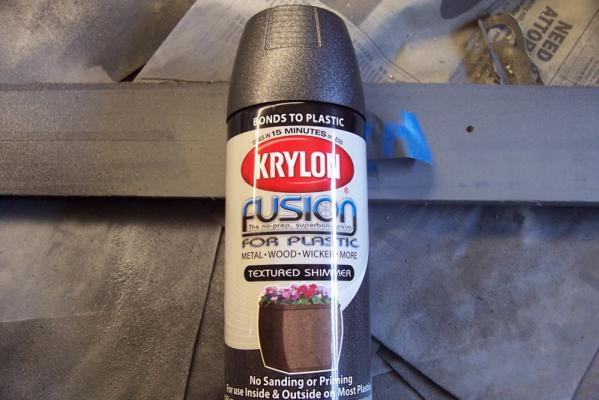-
Posts
739 -
Joined
-
Last visited
Content Type
Profiles
Forums
Gallery
Events
Everything posted by schooner
-
Electronic Countermeasures Tower By the early 1960’s the threat of anti-ship missiles was becoming critical. The FRAMS were equipped with a basic ECM suite capable of either jamming or decoying most of the early (and crude) missiles of the day. The kit provides a mix of wood, metal and PE parts that is an accurate reproduction of the early FRAM ECM suites. Here’s the parts: And here’s what they look like assembled (Stub mast is scratched and the kit- provided railings have not been added yet): As the Vietnam War heated up the ships deploying to the theater were at risk of the rapidly improving Soviet missiles so the ECM suites grew in size and complexity to try to keep up with the threat. Here is what most FRAMs were carrying by the late 1960’s: Since I did not have adequate plans to scratch build that larger array, and mainly because I don’t like the top-heavy look of it I decided to stick with the kit version which was on the Basilone during her 1966 world cruise. The only scratch additions were to the stub mast itself, I replaced the 2 pieces of PE that were to be glued back to back with soldered brass rod, and then I wanted to include these UFO-looking antennas that sat on the stub mast: Here is what I came up with: And here is the finished ECM tower mounted on the top of the DASH hanger:
- 144 replies
-
- basilone
- BlueJacket Shipcrafters
-
(and 2 more)
Tagged with:
-
Motor Whaleboat & Davits MWB The kit provides an excellent casting of the MWB. Most of the cleanup is on the exterior, which is good since it is a lot harder to file off excess material in the compartmented interior. The only drawback to the casting is that the rudder has no space for the prop & shaft so if you decide to add them you will have to make some modifications. Here’s the casting: I cut off the rudder, drilled a hole in the hull for the prop shaft and fabricated a prop out of plastic “blades” glued to the shaft. It looks pretty awful under a magnifying glass but to normal eyesight it looks pretty realistic (it’s only about 1/16” in diameter). I then cut a new rudder with a space for the prop and glued it back on. Other details added are the rub rails on the side, the overboard discharges, back brace for the coxswain, and the steering wheel (the kit PE has an extra anchor windlass wildcat that works great for this) Here’s the finished MWB: The davits are 2 pcs of casting. I thought this would be a 5 minute job but when researching some photos online I found some stuff that should be added. Here’s the casting: Here’s some shots of the real things: The kit instructions call for using some wire for the boat falls but I wanted to rig the blocks if I could. First thing I noticed was that the upper blocks are unusual in that they are semicircular and are fixed to the davits so I scratched some out of plastic rod and sheet. Eyes were added to the top of the davits where the vangs will be attached. A single block was added to the side of each davit to guide the falls from the upper block to the cleats on the base (also added from plastic and wire). Looking at this set up I was surprised at just how old fashioned it was, I didn’t think the Navy still used radial arm davits, rope boat falls and snubbing cleats in the 1960’s. Sure it was reliable but it was also a pretty dangerous way to launch a boat. Raising it was also complicated with the falls having to be led to the fantail where a double headed winch was located. All in all a very manpower intensive operation where plenty could go wrong. Here’s the finished davits and also the kit provided vegetable lockers and two flag bags:
- 144 replies
-
- basilone
- BlueJacket Shipcrafters
-
(and 2 more)
Tagged with:
-
Focsle & Fantail Deck Furniture Fanfare Reel The FRAMs carried the MK6 Fanfare Torpedo Countermeasure system, consisting of a noisemaker towed behind the ship to spoof acoustic torpedoes. Here’s what it looked like: I scratched a reel out of leftover PE line reels from the kit with the foundation, gearboxes, motor, etc made from styrene. All this is some small stuff that will sit on the focsle and fantail, things like horizontal hatches, vertical vent blowers scuttle, line reels. The stuff on the left is OOB from the kit, the things on the right are scratch, and the stuff in the middle is a combination of both:
- 144 replies
-
- basilone
- BlueJacket Shipcrafters
-
(and 2 more)
Tagged with:
-
5” Practice Loader Like most ships armed with 5” guns in the early 60’s, the Basilone had a practice loading machine so that the crews could increase the manually-loaded guns’ rate of fire and not get killed or hurt in the process. The electro-mechanical based analog fire control systems of that day were not nearly as “tight” as the computer-based digital systems in use today that can come close to delivering “one shot - one hit,” even on high-speed maneuvering targets. In order to increase the probability of getting a kill on an air target the number of rounds had to be increased by increasing the rate of fire. An equally important goal was to reduce the risk of loading crews getting hurt. The inside of a 5 inch gun mount is very constricted, every surface is slick with oil, grease or hydraulic fluid. The mounts slewed rapidly when tracking a target making it difficult to maintain balance and footing and anyone who failed to remain clear of the recoiling gun would have been mashed; hence the use of practice loaders that allowed the crews to choreograph their movements without the risk of getting hurt. Here’s a shot of a WWII gun crew practicing on a loader: The kit provides a brittania casting that is really quite good given its size. Since I wanted to include the open base and the loading platform I decided to scratch my own. The two castings on the left where ordered from HR Products, the better one on the right is the kit-provided one. Here’s the finished scratch version with the kit casting as a comparison:
- 144 replies
-
- basilone
- BlueJacket Shipcrafters
-
(and 2 more)
Tagged with:
-
ASROC RAMMER RAIL STOWAGE The final big piece for the ASROC deck is the long stowage locker for the ram rail for the ASROC Loader. Here’s what it looked like: The kit provides a rectangular piece of laser cut wood and a small piece to support it off the deck. In this pix I’ve already rounded the edges and added a door to the front with some plastic bits to give the impression of a waffle pattern ( there was no way I could fit 16 at this scale so I’m just going for the impression): Here’s what it looks like after the addition of the access scuttle, hose rack, support legs, braces, and stiffeners. The blueprints indicate that the area under the locker was used to stow “portable” fenders. The Navy has always had a pretty loose definition of “portable,” if it took 6 men and a boy to move something it was still considered portable. I scratched some fenders to place under it. I needed a life ring for here and other places on the build but I could not find any after marked items. I called Bluejacket to see if they had any (they didn’t) but Dr Al Ross, the kit’s designer had a good idea - use 1/8” hollow plastic tubing, which I did. The inner diameter was increased with a rat tail file and the outside edge filed to a rounded edge, it was cut to length (short!) and the edge rounding repeated on the new face. Some paper strips serve as the mounting brackets. Here’s the locker and fenders after painting. Finally here are the major pieces of the ASROC deck dry fitted to show their relationship (lockers and vents will be added later):
- 144 replies
-
- basilone
- BlueJacket Shipcrafters
-
(and 2 more)
Tagged with:
-
Torpedoes The FRAMs carried MK 44 Acoustic torpedoes, they were carried by the DASH drone, used on the ASROC missiles and in the over-the-side MK 32 Torpedo Tubes. Here’s what they looked like: I wanted to include one on the DASH to help show what it was for and I noticed from the blueprints that there was a “dummy torpedo stowage” rack on the ASROC deck. A little photo research turned up this pix showing the Secretary of the Navy addressing Basilone’s crew. This pix brought back some memories, first of all its easy to assume it was taken in the MED since there is a Soviet cruiser anchored in distance. Since the Soviets couldn’t get access to most ports during the cold war they spent weeks anchored near Cyprus at a “shallow” spot known as Kithra anchorage, it was for all intent open ocean and the anchorage was on a seamount that could barely be reached using all the anchor chain onboard. Since they were there that’s where the USN was too. You can bet that SECNAV thinks the crew is thrilled that he is there and you can assume the crew cares only about the fact that this guy is eating up their off-watch time. On the right side of the photo the torpedo chocks can be see so I’ll make mine to match. Fortunately the MK44’s had a 12 inch diameter which at 1/192 scale comes out to 1/16”, a standard size for plastic rod. After cutting the rod to length it was easy to chuck them up in a Dremel and give the warhead end a bevel and narrow down the aft end so they look like this: A little strip plastic to simulate the steering vanes and their shroud, and then painting the DASH one to look like a warshot and the dummy torps blue they look like this:
- 144 replies
-
- basilone
- BlueJacket Shipcrafters
-
(and 2 more)
Tagged with:
-
I was struck by the sharpness of your white trim around the hull, particularly since you had to zig and zag around a lot of projections. Any tricks to how you did it or was it just a matter of taping it off with lots of trimming and adjusting?
- 2,250 replies
-
- model shipways
- Charles W Morgan
-
(and 1 more)
Tagged with:
-
ASROC Loader The loader was used to pick up ASROC missiles from a dolly or container and ram them into the box launcher. The kit provides several britannia metal pieces and 2 brass PE pieces (not shown). I won’t be using the PE on my build because the long loading arm was usually stowed away except when actually loading. Here’s the brittania parts: Here’s what the loading arm with a missile looked like: The loader had a real rat’s nest of hydraulic lines that I would like to include an impression of so I’ll scratch build the loader out of plastic, brass wire and paper. Here’s what I ended up with: DASH Drone The DASH was used to deliver torpedoes or nuclear depth charges at ranges beyond what the ASROC could reach (always a good idea when dropping a nuclear weapon) The kit provides a brittania body and several pieces of PE, the only details I’ll add will be some of the push rods below the rotor blades. Here’s what it looks like assembled And here it is painted (red and green sides so the operators could figure out what side they were looking at) . Fortunately I had some 1/700 decals which worked great for the dash insignia and warning stripes at this size.
- 144 replies
-
- basilone
- BlueJacket Shipcrafters
-
(and 2 more)
Tagged with:
-
Thanks Brian. I'm impressed with your Bismarck, I've heard of the kit but I was not aware it had so much PE, you'll earn a PhD in PE by the time you finish it. Tim
- 144 replies
-
- basilone
- BlueJacket Shipcrafters
-
(and 2 more)
Tagged with:
-
Wow. I've been putting off making these for my Willie B because my soldering skills are a little shaky but if you could keep the old solders from melting when making the new ones using alligator clips and damp towels maybe I can too. Great job on the dredges!
- 113 replies
-
- model shipways
- willie l bennett
-
(and 1 more)
Tagged with:
-
Hi Rick, I'm moving a little slowly on the Basilone because Trout stocking season has just started here in Virginia and the weather is perfect, and of course postseason baseball has just started with the Nationals actually in the middle of it. Hopefully I'll be making another small post in a day or two. Keep plugging away on the Willie B. - I learned more from that build than all the others I have done. Tim
- 144 replies
-
- basilone
- BlueJacket Shipcrafters
-
(and 2 more)
Tagged with:
-
Rick, Glad to have a real destroyerman following along on this build! Your work on the Willie B will put you in good stead for taking on the FRAM kit. Just like the Willie B's instructions the ones for the Gearing kit tell you what to do but not always how to do it. You will also find that the Gearing requires less scratch building than the skipjack does so, with the exception of carving the solid hull, you should not see anything that you haven't done before -plus you won't have to sew any sails! Tim
- 144 replies
-
- basilone
- BlueJacket Shipcrafters
-
(and 2 more)
Tagged with:
-
ASROC Control Station The FRAMS had control station for the ASROC Launcher that also served as a security control point since the system was nuclear capable The kit provides a resin casting for the control station that is perfectly servicable. Unfortunately for my use, the windows on it are a style that the Basilone did not have so I will scratch build the station. Using sheet plastic and the kit’s casting as a guide it was pretty easy to fabricate a new one. The kit also provides 2 pieces of Brittania metal to serve as the Replenishment at Sea (RAS) king posts which are located on the front of the station. I decided to build my own out of plastic because I find it easier to work with and I wanted to add an extra support leg to each kingpost. Here’s the station with the kingposts: After that it was just a matter of adding some scratch details. I needed a loudspeaker for the front of the station so I made enough for the rest of the build while I was at it. The details include: lifejacket lockers on top Launcher train warning bell Launch warning siren windshield wiper motor Floodlight Padeyes, longlinks and cleats on the RAS posts (the white stuff) several photo etched aluminum safety placards (never read) Sound powered phone storage box junction box WT door
- 144 replies
-
- basilone
- BlueJacket Shipcrafters
-
(and 2 more)
Tagged with:
-
Carl, Looks like you picked a beauty, should turn out to be a great model. Could I ask you to pull a quick measurement off the plans? I'd like to know the max length of the model, from the tip of the bowsprit to the aft most end of the boom on the main mast. I'm asking because the Model Shipways catalog shows the length as 36.5" but I happen to have a copy of the box cover (sent as packing material when I ordered another MS kit) and it shows the model's length as 43". Could you tell me which is correct? thanks Tim
-
ASROC Launcher The kit provides 2 resin pieces and a Brittania base. Given the large size of this item I thought it would lend itself to some scratch additions, unfortunately I got a little carried away and added about 50 pieces which is a bit much at this scale Here is what the parts look like after the addition of the scratch items to include: circular and rectangular inspection and access plates on the sides of the base curved ladders on the front of the base perforated I-beam stiffners on the top of the box cooling water channels on the top of the box drilled out the access ports on the doors where firefighting applicators could be inserted in case of a motor ignition And here’s the completed assy after painting:
- 144 replies
-
- basilone
- BlueJacket Shipcrafters
-
(and 2 more)
Tagged with:
-
Bill, great looking build! Couple of questions: - Where did you get your plans? - What types of things are you using HR products for (I know there isn't much available from anyone in 1/16 scale)? How would you rate their quality? - I've been looking at this BJ kit for sometime as a possible future build - did you find thinning the bulwarks difficult? Looking forward to following this one! Tim
-
Foxy, I've had this kit in its box sitting behind some furniture in my living room for 10+ years, unaware the PE kit was out there. Now I'm thinking it may be time to break it out and follow along behind you. Great work so far. Tim
-
MK32 Torpedo Tubes Summer activities have slowed work on the model but I'm getting some small stuff done. The 2 torpedo mounts were easy. They consist of 3 tubes and a base, all cast brittania. The bottom 2 tubes rest on the base and the top tube rests on the two lower ones but since the breach ends are larger than the muzzle ends some spacers were added to keep the axis' of all three tubes parallel. The photo above shows what the mount looks like without the spacers. Scratch additions include various junction boxes, fine wire to simulate knobs, a long storage tube on the upper tube, and the fiberglass muzzle covers
- 144 replies
-
- basilone
- BlueJacket Shipcrafters
-
(and 2 more)
Tagged with:
-
More Non-skid Finished the non-skid tracks on the rest of the decks and the final waterways and scuppers. All the superstructure pieces are just dry fitted at this point. Flight deck markings are a combination of: - Spray paint (landing circle) - Dry transfer decals (numbers) - Pin striping tape (deck edges) Finished up with a coat of dull-coat. The lines in the center of the flight deck are etchings in the laser cut deck to represent the plates covering a collapsible replenishment kingpost. Only scratch adds are 2 escape scuttles. Next item will be adding striping to the deck edges to cover up the I-beam ends and add deck coamings.
- 144 replies
-
- basilone
- BlueJacket Shipcrafters
-
(and 2 more)
Tagged with:
-
Thanks Dan, the rest of the decks will be much easier to mask off since there are no bulkheads nearby
- 144 replies
-
- basilone
- BlueJacket Shipcrafters
-
(and 2 more)
Tagged with:
-
MK37 Gunfire Control System Director Very simple – consists of a resin main piece, Britannia radar dish and optical range finder arms and PE supports . The only scratch additions are the RF feed horn in the center of the dish, canvas bloomers on the range finder and a simulated retracted canvas cover behind the Director Officer’s position. Hard to believe they fit 7 guys in that little box, when I served as the D.O on a slightly smaller director there were only 2 of us in there and it was still a tight fit. Operations Office and Signal Shelter The kit comes with a resin signal shelter that accurately represents the shelter on 95% of the FRAMS – about the size of 2 phone booths (I know the younger half of the readers of this post are asking themselves “What the Hell is a phone booth?”) Unfortunately Basilone and a couple of her sisters who received their FRAM upgrade at the Philadelphia Naval Shipyard had a much larger structure installed: a rectangular Operations Department Office with a u-shaped signal shelter wrapped around its aft end. The mainmast went thru the center of the Ops Office. Not sure who came up with that bright idea – the higher above the keel the greater the effect of the ship’s rolls and FRAMS rolled a lot. Given that the Ops office was located at the very top of the ship and had no windows it must have been a real vomitorium. I made the structure out of sheet plastic, although wood would probably have been easier. The doors on the signal shelter portion needed to have rectangular windows (not available from the commercial PE frets) so I had to scratch those from plastic with bits of wire for the dogs. Waterways I decided to add waterways on the main deck, they run just inboard of the deck edge and serve to direct rainwater and saltspray to overboard drains (scuppers) to keep the sides from looking dirty. Thin .01x.03 plastic strip edge glued to the deck worked fine. They will have the advantage of serving as good anchoring points for the bottom rung of the PE railings when those are added later. Non-Skid Steel decks are very slippery when wet, add some oil, grease or even accumulated salt and they can be impossible to walk on in any kind of sea so Navy ships lay down rough, textured paint to provide safe walking areas. I wanted to try to include it but wasn’t sure how. I experimented with 400 grit sand paper cut to shape and glued to wood then spray painted the appropriate color. It came out looking really good but I was concerned that it might peel up at some point down the road. Looking around some plastic modeling sites for ideas I ran across this stuff, it is sold at hardware stores and sprays on as a texture, you can hear it crackling as it dries. I have no idea what anyone would use this stuff for but it works well for non-skid. After masking off the areas where it won’t be it was sprayed on, then a coating of flat black primer was added since the texture paint has some shine to it. It would be hard to get it "wrong" since there was no standard pattern for putting it down so each ship was different and even the same ship might change non-skid patterns every time the laid it down. Here’s what the upper superstructure looks like with non-skid, the MK37 Director and the Ops Office/Signal Shelter dry fitted.
- 144 replies
-
- basilone
- BlueJacket Shipcrafters
-
(and 2 more)
Tagged with:
-
Thanks Patrick. Although I enjoy doing this kind of stuff I've figured out that 1/192 is the smallest scale I can handle - I have no idea how the folks working with 1/350 scale, let alone 1/700, do it.
- 144 replies
-
- basilone
- BlueJacket Shipcrafters
-
(and 2 more)
Tagged with:
-
DASH Hanger Very simple assembly. The usual 3 lifts of wood topped by a sheet plastic deck. The only anomaly was during my trip up to the USS Joseph P. Kennedy Jr in Fall River Mass I noticed that she had 9 blow-out hatches on the forward face of the hanger/ASROC magazine, not 6 as per the kit instructions. After I got home I did some research and found out that the Basilone had 9 too. Problem was that there was not enough room to fit the extra 3 hatches because the kit assembly has the starboard half the hanger extending about 1/16” forward of the port on the forward face. Checking the plans the forward face should be flush so I removed all the PE and sanded the forward face flush and made up 3 extra hatches out of plastic to match the 6 PE hatches. The large WT doors on the fore and aft faces are from the 1/192 USN Door set from Tom’s Modelworks. Fortunately the fret had a few large doors which correspond to the doors on these ships at that location, needed to move the ASROC missiles in and out of the magazine. 5/38 Gun Mounts The mounts are cast from resin with Brittania metal barrels and mounting rings. I removed the gun captain hoods from the top of the mount because Basilone didn’t have them. The bottom of the castings are drilled out to accommodate the mounting rings with a length of 1/16” brass rod to pin them together. The rings have a shallow collar that the mount rests on but to my eye that made the bottom of the mount sit too high of the deck so I removed the collar, I also extended the brass rod so that I could use it to pin the mount to the main deck. The barrels have a circular base that is trimmed at whatever angle you want the barrels to be at – I made the aft mount level and the forward mount elevated to match the rise of the focsle. I drilled out the ends of the barrels using the smallest bit I had (size 71) and then enlarged the holes with a rat tail file. The kit provides PE vertical ladders, I added the reinforcing bars on the forward mount (meant to protect it from breaking seas), access panels on the sides, the canvas gun bags (bloomers) around the base of the barrels,the mechanical train stops on the bottom of the front of the mount, aftermarket PE doors, hatches and grabrails. Next up will be the Gun Director assembly
- 144 replies
-
- basilone
- BlueJacket Shipcrafters
-
(and 2 more)
Tagged with:
About us
Modelshipworld - Advancing Ship Modeling through Research
SSL Secured
Your security is important for us so this Website is SSL-Secured
NRG Mailing Address
Nautical Research Guild
237 South Lincoln Street
Westmont IL, 60559-1917
Model Ship World ® and the MSW logo are Registered Trademarks, and belong to the Nautical Research Guild (United States Patent and Trademark Office: No. 6,929,264 & No. 6,929,274, registered Dec. 20, 2022)
Helpful Links
About the NRG
If you enjoy building ship models that are historically accurate as well as beautiful, then The Nautical Research Guild (NRG) is just right for you.
The Guild is a non-profit educational organization whose mission is to “Advance Ship Modeling Through Research”. We provide support to our members in their efforts to raise the quality of their model ships.
The Nautical Research Guild has published our world-renowned quarterly magazine, The Nautical Research Journal, since 1955. The pages of the Journal are full of articles by accomplished ship modelers who show you how they create those exquisite details on their models, and by maritime historians who show you the correct details to build. The Journal is available in both print and digital editions. Go to the NRG web site (www.thenrg.org) to download a complimentary digital copy of the Journal. The NRG also publishes plan sets, books and compilations of back issues of the Journal and the former Ships in Scale and Model Ship Builder magazines.


